Introduction
Cronbach's alpha is the most common measure of internal consistency ("reliability"). It is most commonly used when you have multiple Likert questions in a survey/questionnaire that form a scale and you wish to determine if the scale is reliable.
Example
A researcher has devised a nine-question questionnaire with which they hope to measure how safe people feel at work at an industrial complex. Each question was a 5-point Likert item from "strongly disagree" to "strongly agree". In order to understand whether the questions in this questionnaire all reliably measure the same latent variable (feeling of safety) (so a Likert scale could be constructed), a Cronbach's alpha was run on a sample size of 15 workers.
Setup in SPSS
The nine questions have been labelled "Qu1" through to "Qu9". To know how to correctly enter your data into SPSS in order to run a Cronbach's alpha test please read our Entering Data into SPSS tutorial.
Test Procedure in SPSS
- Click Analyze > Scale > Reliability Analysis... on the top menu as shown below:
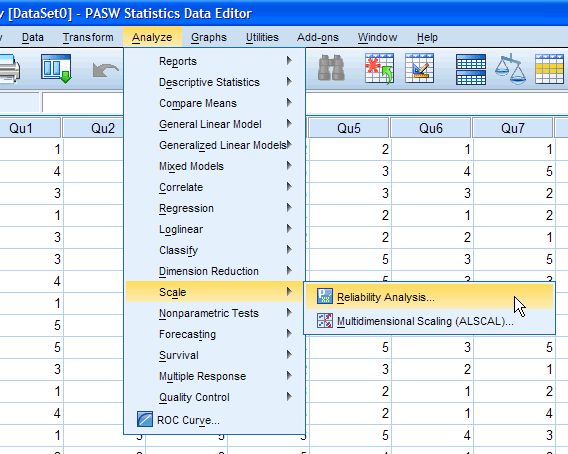
Published with written permission from SPSS Inc, an IBM Company.
- You will be presented with the Reliability Analysis dialogue box:
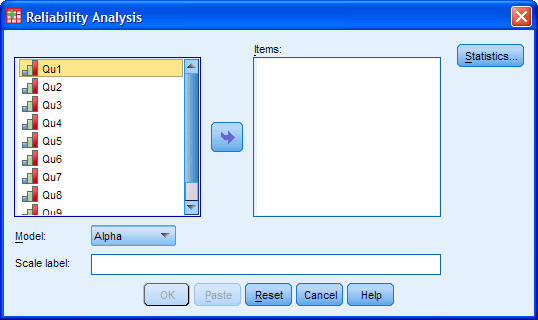
Published with written permission from SPSS Inc, an IBM Company.
- Transfer the variables "Qu1" to "Qu9" into the "Items:" box. You can do this by drag-and-dropping the variables into their respective boxes or by using the
 button. You will be presented with the following screen:
button. You will be presented with the following screen: 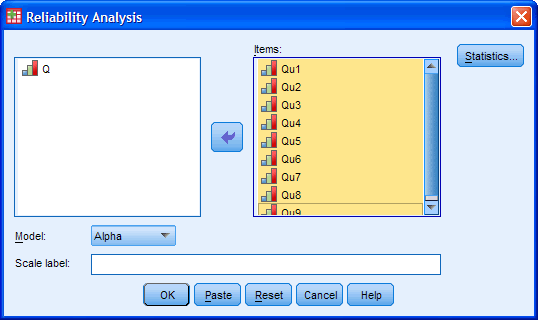
Published with written permission from SPSS Inc, an IBM Company.
- Leave the "Model:" set as "Alpha", which represents Cronbach's alpha in SPSS. If you want to provide a name for the scale enter it in the "Scale label:" box. Since this only prints the name you enter at the top of the SPSS output, it is certainly not essential that you do; and in this case we will leave it blank.
- Click on the
 button, which will present the Reliability Analysis: Statistics dialogue box, as shown below:
button, which will present the Reliability Analysis: Statistics dialogue box, as shown below: 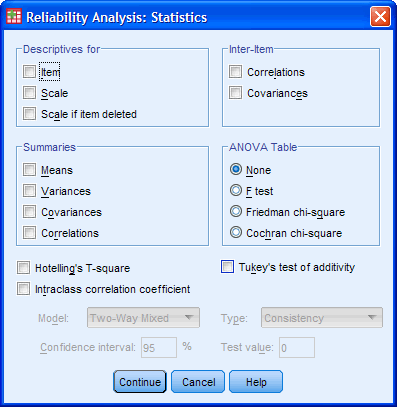
Published with written permission from SPSS Inc, an IBM Company.
- Select the "Item", "Scale" and "Scale if item deleted" in the "Descriptives for" box and "Correlations" in the "Inter-Item" box, as shown below:
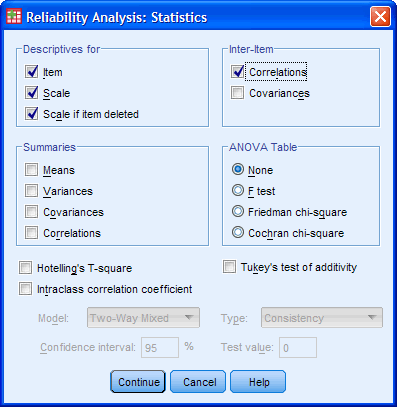
Published with written permission from SPSS Inc, an IBM Company.
- Click the
 button. This will return you to the Reliability Analysis dialogue box.
button. This will return you to the Reliability Analysis dialogue box. - Click the
 button to generate the output.
button to generate the output.
SPSS Output for Cronbach's Alpha
SPSS produces many different tables. The first important table is the Reliability Statistics table that provides the actual value for Cronbach's alpha, as shown below:
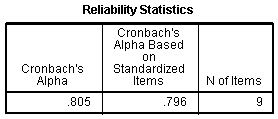
Published with written permission from SPSS Inc, an IBM Company.
We can see that in our example, Cronbach's alpha is 0.805, which indicates a high level of internal consistency for our scale with this specific sample.
Item-Total Statistics
The Item-Total Statistics table presents the Cronbach's Alpha if Item Deleted in the final column , as shown below:
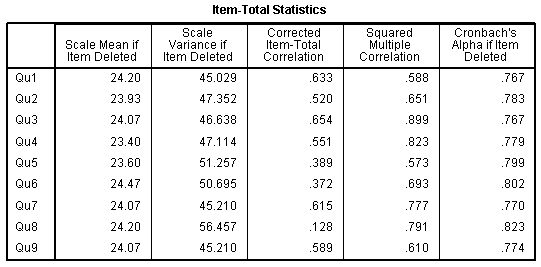
Published with written permission from SPSS Inc, an IBM Company.
This column presents the value that Cronbach's alpha would be if that particular item was deleted from the scale. We can see that removal of any question except question 8, would result in a lower Cronbach's alpha. Therefore, we would not want to remove these questions. Removal of question 8 would lead to a small improvement in Cronbach's alpha and we can also see that the Corrected Item-Total Correlation value was low (0.128) for this item. This might lead us to consider whether we should remove this item.
Cronbach's alpha simply provides you with an overall reliability coefficient for a set of variables, e.g. questions. If your questions reflect different underlying personal qualities (or other dimensions), for example, employee motivation and employee commitment, then Cronbach's alpha will not be able to distinguish between these. In order to do this and then check their reliability (using Cronbach's alpha), you will first need to run a test such as a principal components analysis (PCA). If this sounds like something you would want to do, check out the features of our Premium PCA guide, here.











0 komentar:
Posting Komentar